|
Mexican
Folkloric Dance: Bailamos?
By: Philip
Conatser, Univ. of Texas at Brownsville & Zelma Mata, The University of Texas at Brownsville & Texas Southmost College
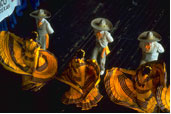 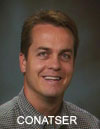 Instead
of an article over a given topic, I
decided to do something a little different
by interviewing a dance professor of
30 plus years. The interview consist
of a brief bio of Dr.
Zelma Mata, a historical perspective
of Mexican folkloric dancing, benefits,
objectives, selection, terminology,
two easy to learn dances, and of course
some simple modifications for people
with disabilities. I hope everyone enjoys
this article, and is inspired to try
Mexican folkloric dancing as much as
I was after this interview. Instead
of an article over a given topic, I
decided to do something a little different
by interviewing a dance professor of
30 plus years. The interview consist
of a brief bio of Dr.
Zelma Mata, a historical perspective
of Mexican folkloric dancing, benefits,
objectives, selection, terminology,
two easy to learn dances, and of course
some simple modifications for people
with disabilities. I hope everyone enjoys
this article, and is inspired to try
Mexican folkloric dancing as much as
I was after this interview.
A little about Dr. Mata
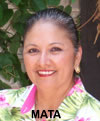 Dr.
Zelma
Mata is a former Vice President
and Region II Texas Representative for
the Asociación
Nacional de Grupos Folklórico
(ANGF). ANGF is a national organization
dedicated to the preservation and the
promotion of the Mexican cultural heritage
through dance and music. Respectfully,
she served on the ANGF executive board
for four consecutive years. Dr. Mata
has been a college professor for over
30 years, and is currently the Health
and Human Performance department chair
for The
University of Texas at Brownsville.
She is the founder of the Grupo Folklórico
de The University of Texas at Brownsville
student organization on campus. The
grupo was founded in 1988, and since
its inception has been very active in
promoting the cultural heritage of the
locale through Mexican folklórcio
dance. The grupo averages 25 performances
a year for the university, public schools,
civic organizations, national organizations,
and the general community. In addition
to being involved with Mexican folklórico
from the performance aspect, Dr. Mata
has contributed greatly to developing
opportunities in education. She developed
the curriculum for the folklórico
class taught at UTB, as well as offering
folklórico workshops to the educators
in the South Texas area. Dr.
Zelma
Mata is a former Vice President
and Region II Texas Representative for
the Asociación
Nacional de Grupos Folklórico
(ANGF). ANGF is a national organization
dedicated to the preservation and the
promotion of the Mexican cultural heritage
through dance and music. Respectfully,
she served on the ANGF executive board
for four consecutive years. Dr. Mata
has been a college professor for over
30 years, and is currently the Health
and Human Performance department chair
for The
University of Texas at Brownsville.
She is the founder of the Grupo Folklórico
de The University of Texas at Brownsville
student organization on campus. The
grupo was founded in 1988, and since
its inception has been very active in
promoting the cultural heritage of the
locale through Mexican folklórcio
dance. The grupo averages 25 performances
a year for the university, public schools,
civic organizations, national organizations,
and the general community. In addition
to being involved with Mexican folklórico
from the performance aspect, Dr. Mata
has contributed greatly to developing
opportunities in education. She developed
the curriculum for the folklórico
class taught at UTB, as well as offering
folklórico workshops to the educators
in the South Texas area.
Doctor Mata was awarded with the 2002
Advocate for Education of Young Children
Award bestowed by the Brownsville Association
for the Education of Young Children.
In 2003, Dr. Mata was selected among
62 women from throughout the U.S., Puerto
Rico, and Africa to attend the Summer
Institute for Women in Higher Education
held at Bryn Mawr College in Pennsylvania.
She received The University of Texas
System Chancellor’s Teaching Award
in 1999, and The National Institute
for Staff and Organizational Development
in 2006. She was also recently named
“Dance Teacher of the Year”
by Texas AHPERD 2007. These awards symbolize
her dedication to Mexican folklórico
dance, and her dedication to providing
students with meaningful cultural experiences.
With all of her experience and accolades,
she is very humble and regards herself
as always a “student of the dance.”
Brief History of Folkloric
Dance
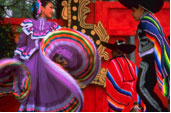 Folk
dances may be defined as the traditional
dances of a given country which have
evolved naturally and spontaneously
in conjunction with the everyday activities
and experiences of the people who developed
them. Folk dances are related in origin
to everything of importance in the daily
lives of a specific people at given
times in their history, stemming from
customs, beliefs, emotions, and events
related to religion, war, occupations,
ceremonies of birth, courtship, marriage,
death, daily activities of domestic
life, superstitions, rituals, festivals,
and innumerable themes common to all
peoples everywhere. Thus, Mexican folklórico
dance depicts the history, customs,
beliefs, rituals, and events which embrace
the people it represents. Mexico is
divided into 32 states. Each state has
its own dances that reflect the unique
characteristics of the cultural heritage
for the various regions of the state. Folk
dances may be defined as the traditional
dances of a given country which have
evolved naturally and spontaneously
in conjunction with the everyday activities
and experiences of the people who developed
them. Folk dances are related in origin
to everything of importance in the daily
lives of a specific people at given
times in their history, stemming from
customs, beliefs, emotions, and events
related to religion, war, occupations,
ceremonies of birth, courtship, marriage,
death, daily activities of domestic
life, superstitions, rituals, festivals,
and innumerable themes common to all
peoples everywhere. Thus, Mexican folklórico
dance depicts the history, customs,
beliefs, rituals, and events which embrace
the people it represents. Mexico is
divided into 32 states. Each state has
its own dances that reflect the unique
characteristics of the cultural heritage
for the various regions of the state.
There are three categories of Mexican
folkloric dance that correspond to the
historical beginnings of the dance.
A danza
is a dance that is indigenous
in nature, and may have religious connotations
which are often performed in ritual
and community settings. The mestizo
dances reflect the European influences,
be it in the dance steps, the instrumentation,
the costuming or a combination of these
elements. Bailes regionales are regional
dances that are primarily social in
origin and manifestation and are often
presented in community and theatrical
performances.
Why should someone start dancing?
Dancing is fun and a great way to learn
about cultural heritage. Also dancing
is a good form of exercise because it
promotes fitness and lowers stress.
Dancing is multicultural “universal”,
in that everyone can experience and
enjoy together. Advanced or beginner,
old or young, disabled or nondisabled
everyone can benefit from dancing.
Objectives
Instruction in Mexican folklórico
dance offers the same benefits as in
the teaching of any folk dance. Some
of the specific student learning objectives
in the teaching of Mexican folklórico
dance include that the student will
be able to:
– Acquire an appreciation and
better understanding of the Mexican
culture;
– Acquire basic dance skills in
folklórico dance;
– Acquire knowledge of the terminology
used in folklórico dance;
– Acquire knowledge of the origin
and costuming of the folklórico
dances learned in class.
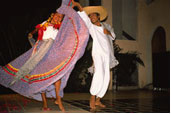 Selection Selection
In the selection of a Mexican
folkloric dance it is important to investigate
the historical origin and significance
of the dance, know the geographical
location of the region it represents,
and be familiar with the costuming and
accessories, the basic steps, and terminology
that pertain to the specific dance.
The musical selection must be authentic
and traditional in order to accurately
depict the instrumentation of the dance.
The instruction of the dance must include
all of these elements in order to teach
the complete cultural heritage of the
dance, and not simply teach a series
of dance steps to a song. Shoes for
folkloric dancing are specifically made
to enrich the foot stomping or the zapateado
depending on the dance.
Basic Terminology
It is important to use the correct terminology
and language in the teaching of the
basic dance steps, or the pasos,
through the footwork referred to the
as the zapateado.
The challenge in Mexican folklórico
dance is that not all terms for the
various steps have been standardized,
like in American square dance, which
can result in confusion. It is important
to note that the terms used depend on
the teacher or the maestro.
A quick reference for a selection of
common terms and basic
pasos may include:
Posición
tusa - Standing with the knees
slightly flexed to facilitate and execute
the dance steps or pasos.
Golpe
- Refers to the basic foot stomp on
the floor.
Remate
- Execution of a sequence of foot stomps.
Sequencia
- Combination of steps for a given phrase
of music.
Sencillos
- Single foot stomp which can be alternated
with each foot or repeated with the
same foot. Example: stomp once with
right foot, stomp once with left foot,
etc… May be done in place or in
different lines of direction. The speed
may vary from slow to fast.
Dobles
- Double foot stomp which can be alternated
with each foot or repeated with the
same foot. Example: stomp twice with
right foot, stomp twice with left foot,
etc… May be done in place or in
different lines of direction. The speed
may vary from slow to fast.
Metatarsal
y talón - Landing or
making contact with the ball of the
foot followed with the heel.
Paso
de tres lentos or balseados
- Landing lightly flat footed then alternating
landing with the toes or metatarsal
with the opposite leg and repeat such
as landing whole foot right, toe left
alternating right toe. Similar to the
basic triple step.
Paso
de tres zapateado - Consists
of doing three consecutive stomps alternating
the foot that is doing the action. There
is an accent on the first stomp only
followed by a lighter stomp on the second
and third beat.
Sequidos
- Continuous steps that are done with
scuffing with the heel followed by making
contact with the whole foot such as
scuff right foot on floor and stomp
with right foot then alternate with
the left foot.
These basic pasos and terms can easily
be taught, and serve as a great start
for becoming familiar with Mexican folkloric
dance. Try these easy-to-learn dances.
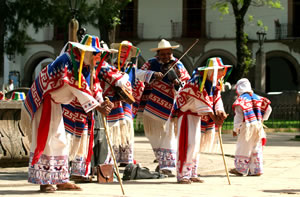
Example
1
Name of dance:
Los
Viejitos (video)
(video)
Mexican State
Origin: Michoacán
Basic steps
(pasos básicos):
sencillos, paso de tres zapateados
Costume:
Shirt and pants are made of manta
material, a jorongo
or a zarape
to drape over the shirt, a straw sombrero
(hat) decorated with colorful ribbons
that hang over the rim, a paliacate
(scarf) to wear under the sombrero,
a moral or peasant bag across the shoulders,
and huaraches
(sandals). A mask,
or máscara,
is worn that resembles the facial features
of an elderly man.
Prop: cane
(bastón)
Style:
Movements mimic an elderly man bending
forward, supporting self with the walking
cane (bastón),
while dancing doing lively energetic
footwork.
Part I
Count 1 - Step back with right foot,
while crossing it behind the left leg
Count 2 - Step back with left foot,
while crossing it behind the right leg
Counts 3-6 - Four quick stomps (sencillos)
walking forward, starting with the right
foot, left foot, right foot, left foot
Repeat Part I Sequence
Count 7 - Step back with right foot,
while crossing it behind the left leg
Count 8 - Step back with left foot,
while crossing it behind the right leg
Counts 9-12 - Four quick stomps (sencillos)
walking forward, starting with the right
foot, left foot, right foot, left foot
Part II
Count 1 - Point forward with the right
foot, while leaning forward for a slight
pause
Count 2 - Point forward with the left
foot, while leaning forward for a slight
pause
Counts 3-6 - Series of four sets of
triple steps (paso de tres zapateados),
or stomping flat-footed, or 3 stomps
for each count
Repeat Combination I thru Combination
II for a total of 4 times
Part III
- Series of 16 sets of triple steps
(paso de tres zapateados), or stomping
flat-footed, or 3 stomps for each count
Repeat dance sequence Part I thru III.
Finish dance by jumping on both feet,
and land with one knee bent while holding
on to the bastón.
Example
2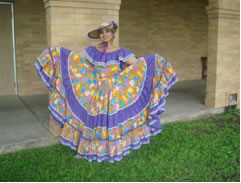
Name of dance:
Las Chiapanecas (video)
(video)
Mexican State
Origin: Chiapas
Basic Steps (pasos
básicos): triple steps
(paso de tres lentos), 3 step turn
Costume:
Chiapaneca
dress which is a tiered dress that
is decorated with colorful embroidery
of flowers. The dancer wears a braid
(trenza)
on her head decorated with ribbon.
Style: Very
graceful
Introduction: Hold
for 8 counts
Part I
Counts 1-4 - Four triple steps (paso
de tres lentos) in place, starting with
the right foot while holding the dress
at shoulder level
Counts 5-8 - Complete turn in place
to the right with arms extended to the
side holding dress at shoulder level
Repeat sequence for a total of 4 times
Part II
Counts 1-5 - Three step turn to right
side by stepping with right foot, left
foot, and right foot, and clap hands
twice at shoulder level
Counts 6-10 - Repeat three step, turn
to the left side, leading with the left
leg
Part III
Counts 1-8 - Step on left leg,while
swinging right leg to left side, repeat
8 times (Holding the dress at shoulder
level, move the arms like a seesaw)
Counts 9-16 - Step on right leg while
swinging left leg to right side, repeat
8 times (Holding the dress at shoulder
level move the arms like a seesaw)
Repeat sequence. Repeat
Part I thru III
Tips for people with disabilities.
In general:
- allow more freedom of expression when
dancing.
- a guided discovery, or movement education
style of instruction is probably best.
- dance surface should be even, consistent
traction, and boundaries clearly marked.
- dance movements might need slowing
down.
- rhythm slowed down.
- allow for more steps between sequences.
- multiple attempts for desired pattered.
- visual clues for feet placement.
- use colored markers or cones on floor
for direction.
- use colored marker for right and left
hands and feet.
- picture for body position.
- extra verbal and physical clues.
- extra encouragement for proper technique.
- beating a drum, maraca, or cymbals
to help establish the tempo.
- cut down the “tasks” from
7 to 8 steps to 3 or 4 steps.
Dancers that are visually impaired:
- should be guided around the dance
floor to help obtain a mental picture
of the area.
- area should be free of obstacles
- bright lighting and colored markers
on the floor
- may benefit from always having physical
contact with their partner
- partner wear bright colored clothes
(reds, violets)
- partner wear bells on wrist
- partner callout directions (where
to move, face)
- partner physically assist as needed
- physical shaping of desired arm movements
might be more effective than verbal
explanation
Dancers that are deaf:
- music should not be turned up high
- more base would enhance the physical
sensation of the beet
Dancers that use wheelchairs:
- may benefit from hand, arm, shoulder,
head, and upper body stretches
- switch leg moments with arm movements
(rolls, waves, swings, slap thighs,
clap hands, clap partner’s hands
- more space between dancers
- partners are allowed to push/pull
the wheelchair when needed
- partners can assist in arm moments
resourses: Danza
de los Viejitos, directory
of many links to dance information.
(pelinks4u
home) |



